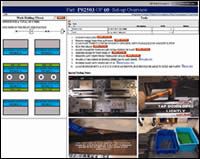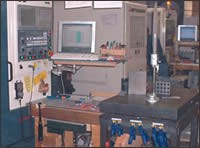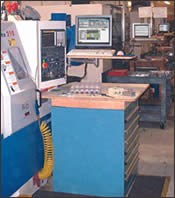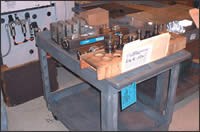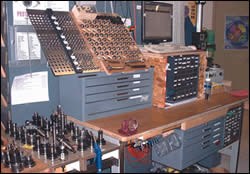Creating A Machine Shop Franchise Template
This contract shop applies basic franchising concepts to maximize efficiency in all aspects of its business. Its intent is not to sow multiple franchise locations, but rather to make its sole facility perform as predictably and profitably as possible.
It's no mystery how fast food chains can build, equip, staff and then open new locations for business in the blink of an eye. These turnkey business systems are based on a proven, predictable franchise template.
A successful franchise template requires utmost efficiency of equipment, processes and management to enable quick and easy replication at another location. In addition, standard practices must be established, and a substantial knowledge base must be made available to the entire workforce. This will allow workers of nearly any skill level not only to learn new job duties in short order, but also carry out those responsibilities without significant management handholding. This concept is detailed in a book written by Michael Gerber called "The E-Myth Revisited" (in this case, the "E" stands for entrepreneurial, not electronic).
There is considerable value in looking at how this might be applied to the business of producing machined parts, even if a shop has no intention of opening another location. The idea is to get that single location as close to "fast food" speed and efficiency levels as possible to best meet customers' JIT and quick delivery needs.
This concept is successfully being applied at Pro CNC in scenic Bellingham, Washington. Pro CNC's management and shop workers continuously seek new ways to increase shop efficiency, as any company would in developing its franchise template. Pro CNC's comprehensive shop management system—an open, Web-based system of its own design—makes readily available all information that a worker may need to set up a job, run a machine or inspect parts. It also tracks every aspect of the manufacturing process from purchase order to part shipment in real time.
Though Pro CNC certainly isn't to the point of having a parts "drive-thru" on the side of its building, the shop has thrived by striving to reach such a level of part-making proficiency.
Efficiency In Motion
Before starting their business, the founders of Pro CNC studied together at Western Washington University, where they joined the school's Vehicle Research Institute (VRI). According to Paul Van Metre, Pro CNC's vice president, they not only designed and built many award-winning Formula SAE-style racecars at VRI, but they also learned a great deal about machine tools and machining processes.
Racecar designs are inherently efficient. Pro CNC applied the concept of design efficiency to its machine shop, which melds lean manufacturing concepts such as 5S (workplace organization) and kaizen (continuous improvement), as well as a variety of setup reduction techniques. A shop tour with Mr. Van Metre revealed numerous examples of how Pro CNC has integrated both standardization and design efficiency into its manufacturing processes.
- Machine layout—When determining the layout of its new 10,000-square-foot facility a few years back, Pro CNC worked with a lean manufacturing consultant to help devise a machine layout that would best match its desire for quick throughput of small part lots. Because many of the parts that the shop produces for its aerospace, medical and sporting goods customers flow between two or more machines, the machine layout needed to allow fluid, efficient worker motion. Rather than establishing cells, the company arranged its machines in rows, and spaced the machines less than 10 feet apart. This minimizes operator walking distance for jobs that might flow between any combination of machines, but it doesn't make the shop floor so cramped that workers are bumping into each other. In order to power auxiliary equipment such as a vacuum table, 120-, 220- and 480-volt electrical outlets are provided at every machine.
- Machine workstations—Small, well-organized worktables at each machine minimize operator movement between tasks and eliminate time-wasting searches for commonly used tools. Limited table surface area encourages the use of quick-access storage devices, including shadow boards, magnetic plates to secure metal tools, and clearly labeled trays and bins. Machine-specific colored tape is attached to some tools to make sure they remain at the proper machine workstation. Each workstation has a computer, keyboard and flat screen monitor located near the machine control for easy access to the shop management system.
- Carts—Pro CNC uses a number of carts to facilitate part and equipment movement throughout the shop. For every new job, a job cart is stocked according to a preprocessing checklist, which lists everything an operator will need to set up and run that particular job. Items on the job cart might include the job folder, material cut to size, preset tools loaded in a caddy, vises or fixtures, buckets of part cleaner, measurement devices and so on. A finished parts cart is positioned at each machine to allow easy part transfer to another machine, the shipping department, or deburring or assembly stations.
Two dedicated inspection carts topped with granite plates enable operators to perform in-process or first-article inspection at any machine. Two "plug-and-play" vacuum table carts contain everything needed to quickly install a vacuum table into a machine, including vacuum pump, vacuum gages, a manifold with quick-release vacuum line fittings and a canister for collecting coolant that might be pulled into the vacuum system.
- Workholding—The shop has 11 CNC machine tools from a number of manufacturers. Though it hasn't standardized on a machine tool manufacturer, it has settled on a means of quickly installing vises and dedicated fixtures into the machines. The bed of each machine is fitted with a subplate drilled to accept locating dowels installed in the bottom of every vise and dedicated part fixture. Vise hole patterns on the subplate allow vises to be positioned in different locations inside the machine. Once positioned over the correct hole pattern for that particular job (using rollers to position the vise so as not to damage the subplate), the vise is bolted to the subplate. Vise dial-in is not necessary because the location of each vise hole pattern on the subplate is known. Once the vise is installed, a macro at the beginning of each part program will set the machine's coordinate system to match the vise zero position.
Pro CNC has standardized on dual-station vises from Toolex (Union, Ohio). These vises can be used in dual-station mode to allow fixturing of multiple parts, but they can also serve as a single-station vise for large parts by removing the center stationary jaw. Pro CNC added custom handles to the ends of these vises for easier handling. Vise setup and maintenance are performed in a vise preparation and storage station. Each vise and fixture is given a serial number that is entered into the shop management system so that anyone accessing the system can know the exact location of any workholding device on the fixture storage rack.
- Tooling—All tools are installed in toolholders and measured using a Trimos presetter at the shop's tool presetting station. After installation into the toolholder and measurement, each tool is given a unique identification number. The tool's measurements are then entered into the shop management system at the presetting station's computer and stored in a virtual tool caddy that corresponds to the actual wooden tool caddy. An operator can then easily download the proper offset files from the virtual caddy to the machine control after tool installation into the machine.
The tool presetting station is a model of efficiency, featuring a healthy mix of organizational "little things" that make the process of installing tools much quicker (See photo below).
Knowledge Base
Pro CNC currently has as many computers as it does employees—30. In addition to the office and engineering department, computers are located at every CNC machine tool, the tool presetting station, the vise assembly area, the shop leader's job scheduling and monitoring station, and the shipping department.
All computers are networked to allow access the shop's Web-based shop management system. The system acts as the shop's central nervous system, tracking virtually every aspect of production in real time. It looks and works similarly to a Web site or company intranet and only requires the Windows Internet Explorer browser for access. Two of its key strengths in terms of the franchise template concept are the ability to provide an open knowledge base and instant employee communication. Shopfloor workers and managers can find information about virtually every aspect of a job and also enter information that might be helpful to others in the shop.
According to Mr. Van Metre, Pro CNC developed its own Web-based system for ease of expansion and the ability to run the system on any number of computers without paying per individual seat of software. Here are just a few ways that the shop management system facilitates communication between all employees.
- Common knowledge—A searchable, global knowledge base allows workers to perform a keyword search (just as one would using an Internet search engine such as Google) to find an answer to particular problem they might be experiencing (plastic parts chipping, for example). Workers can also add to this knowledge base if they think they have information that will be of value to others. Such an open and available pool of information means that an experienced worker who leaves the company won't be taking tribal knowledge along with his or her toolbox. The system also offers thread-based messaging, similar to public web sites, which is another way employees can communicate with one another.
- Complete instructions—All information required to set up, run a job and inspect parts is included in the job's setup page. This may be a combination of text instructions, photos and video. The instructions contain what might be considered obvious information (such as when to blow off chips or when to check for part features) to allow quick ramp-up for a person new to that particular job. The job's CAD/CAM programmer will typically document these steps during a job's first part run.
- Auto messaging—The shop management system is set up to automatically send messages to shop workers or management when tasks are completed or problems arise. Such instances include the moment a new job is assigned to a CAD/CAM programmer, a machining task is over budget, a job is complete and ready to be shipped, or a machine is scheduled for routine maintenance.
- Documentation—All documentation that must be included with a job upon delivery to the customer is automatically generated when the shipping department produces the job's packing slip. Pro CNC asks its customers to fill out a customer profile which, among other things, lists the documentation they require with their parts. Such documentation might include first-article inspection, in-process quality data, material certification, certification of conformance and so on.
- Scheduling—Every job is tracked in real time. So as each part is completed, a progress bar for that job shortens accordingly on a scheduling page. When a job is completed, the job in queue automatically drops into place in the schedule. By knowing the schedule down to the hour often many days in advance, management can accurately schedule work weeks or months ahead of time.
Making It Easier
Workers on the shop's kaizen team spend about 20 percent of each day dedicated to shop improvement activities. A kaizen problem/solution board, located near the shop entrance, provides means for workers to identify an efficiency bottleneck, offer a possible solution and also rank the solution in terms of cost versus payback. "Obviously, the problems that offer highest payback with lowest cost are attacked first," says Mr. Van Metre.
Another way the shop tries to make it easier on its employees is by providing an equipped kitchen and subsidized lunch. Each Monday, a worker will shop for foodstuffs for that week. The shop also tries to make life easier for new and existing customers. Its Web site, for example, is comprehensive, yet easy to navigate. It does more than just provide a list of the company's machine tools; it gives visitors a good idea of what Pro CNC's overall capabilities are and what the company is all about. Pro CNC also provides a toll-free phone number that is derived from the shop's name for easy recall.
The shop is going on 8 years in operation, and Mr. Van Metre admits there still is work to be done. Perhaps if the owners do get their company close to running on autopilot, as any franchise should, they will finally be able to build the car designs floating around in their heads.
Related Content
Building Machines and Apprenticeships In-House: 5-Axis Live
Universal machines were the main draw of Grob’s 5-Axis Live — though the company’s apprenticeship and support proved equally impressive.
Read MoreSolve Worker Shortages With ACE Workforce Development
The America’s Cutting Edge (ACE) program is addressing the current shortage in trained and available workers by offering no-cost online and in-person training opportunities in CNC machining and metrology.
Read MoreThe Power of Practical Demonstrations and Projects
Practical work has served Bridgerland Technical College both in preparing its current students for manufacturing jobs and in appealing to new generations of potential machinists.
Read MoreWorkholding Fixtures Save Over 4,500 Hours of Labor Annually
All World Machinery Supply designs each fixture to minimize the number of operations, resulting in reduced handling and idle spindle time.
Read MoreRead Next
Inside Machineosaurus: Unique Job Shop with Dinosaur-Named CNC Machines, Four-Day Workweek & High-Precision Machining
Take a tour of Machineosaurus, a Massachusetts machine shop where every CNC machine is named after a dinosaur!
Read MoreIncreasing Productivity with Digitalization and AI
Job shops are implementing automation and digitalization into workflows to eliminate set up time and increase repeatability in production.
Read MoreIMTS 2024: Trends & Takeaways From the Modern Machine Shop Editorial Team
The Modern Machine Shop editorial team highlights their takeaways from IMTS 2024 in a video recap.
Read More




